Experimental Oxygen Mass Transfer Study of Micro-Perforated Diffusers
Abstract
:1. Introduction
2. Materials and Methods
2.1. Bubble Size Measurement
2.2. Experimental Setup for Oxygen Transfer
2.3. Oxygen Mass Transfer Measurement
3. Results and Discussion
3.1. Bubble Size Measurements
3.2. Oxygen Transfer Efficiency
3.3. Oxygen Transfer Rate
3.4. Pressure Loss and Aeration Efficiency
4. Conclusions and Outlook
- Micro-perforated diffusers are able to deliver bubbles with . In this case, the micro-perforated plate diffusers are able to generate smaller bubbles than those of the micro-perforated tube diffuser.Regarding the results of the SSOTE, the micro-perforated tube diffuser outperforms the membrane diffusers with up to 50% and 44% higher SSOTE for the lowest flow rate and the highest flow rates, respectively. Additionally, the micro-perforated small tube diffuser surpasses the referenced trend lines by at least 20% and reaches the recommended SSOTE range of 8.5%·m−1–9.8%·m−1.
- In the case of SOTRATV, the micro-perforated tube diffuser achieves 48% diminution in QA,ATV compared to the best accomplished results of the membrane aeration elements. In addition, the novel tube system results in a reduction of the QA,ATV of 33% and 35% compared to the literature trend line.
- The reasons behind the good performance of the micro-perforated tube diffuser are believed to be the fine bubble aeration, with bubble sizes as small as 1.8 mm, and the homogenous spatial bubble distribution.
- The novel tube system results in an improved SAE of up to 20% for QA ≤ 2.4 Sm3·h−1. However, increasing QA results in a decrease in SAE. The latter is shown to be mainly due to the enhanced Δp as QA increases. The resultant SAE of the micro-perforated plate diffusers with 50 µm and 70 µm orifices corresponds to the outcomes of the membrane plate diffuser, although Δp for the micro-perforated plate diffusers is higher than the Δp of the membrane plate diffuser.
Author Contributions
Funding
Institutional Review Board Statement
Informed Consent Statement
Acknowledgments
Conflicts of Interest
Nomenclature
| A | Perforated Diffuser Area | m2 |
| C0 | Dissolved oxygen concentration at t = 0 | kg/m3 |
| CS,20 | Oxygen saturation concentration at T = 20 °C and p = 1013 hPa | kg/m3 |
| CS,St,20 | Oxygen saturation concentration from EN 25814, CS,St,20 = 9.09 mg/L | kg/m3 |
| CS,p*,T | Oxygen saturation concentration at T and p* | kg/m3 |
| Ct | Dissolved oxygen concentration at time t | kg/m3 |
| d | Column diameter | m |
| d32 | Sauter mean diameter | mm |
| DD# | Disc-shaped diffuser | - |
| E0 | Specific energy of blower/compressor | Wh/(m3m) |
| h | Column height | m |
| hD | Aeration depth | m |
| kLa | Volumetric mass transfer coefficient | 1/s |
| kLa20 | Volumetric mass transfer coefficient at 20 °C | 1/s |
| kLaT | Volumetric mass transfer coefficient at T | 1/s |
| MP# | Micro-perforated stainless steel diffuser | - |
| Δp | Pressure drop | hPa |
| p* | Atmospheric pressure | hPa |
| P | Power | kWh |
| PD# | Plate-shaped diffuser | - |
| q | Volumetric gas flow rate per orifice | m3/s |
| QA | Gas flow rate for standard conditions | Sm3/s |
| QA;ATV | Gas flow rate per aerated tank volume area for standard conditions | Sm3/(m3TVh) |
| QA,DA | Gas flow rate per diffuser area for standard conditions | Sm3/(m2h) |
| SAE | Standard aeration efficiency | kg/kWh |
| SSOTE | Specific standard oxygen transfer efficiency | %/m |
| SOTR | Standard oxygen transfer rate | kg/h |
| SOTRATV | Standard oxygen transfer rate per tank volume | Kg/(m3TVh) |
| T | Temperature | °C |
| TD# | Tube-shaped diffuser | - |
| V | Filled column volume (tank volume) | m3/m3TV |
| σ | Electrical conductivity | µS/cm |
| Υ | Exponent for blower type | - |
References
- Masłoń, A.; Czarnota, J.; Szaja, A.; Szulżyk-Cieplak, J.; Łagód, G. The Enhancement of Energy Efficiency in a Wastewater Treatment Plant through Sustainable Biogas Use: Case Study from Poland. Energies 2020, 13, 6056. [Google Scholar] [CrossRef]
- Metcalf, L.; Eddy, H.P.; Tchobanoglous, G. Wastewater Engineering: Treatment, Disposal, and Reuse; McGraw-Hill New York: New York, NY, USA, 1991; Volume 4. [Google Scholar]
- Motarjemi, M.; Jameson, G. Mass transfer from very small bubbles—The optimum bubble size for aeration. Chem. Eng. Sci. 1978, 33, 1415–1423. [Google Scholar] [CrossRef]
- Kantarci, N.; Borak, F.; Ulgen, K.O. Bubble column reactors. Process Biochem. 2005, 40, 2263–2283. [Google Scholar] [CrossRef]
- Jin, B.; Yin, P.; Lant, P. Hydrodynamics and mass transfer coefficient in three-phase air-lift reactors containing activated sludge. Chem. Eng. Process. Process Intensif. 2006, 45, 608–617. [Google Scholar] [CrossRef]
- Alkhalidi, A.; Amano, R. Bubble Deflector to Enhance Fine Bubble Aeration for Wastewater Treatment in Space Usage. In Proceedings of the 50th AIAA Aerospace Sciences Meeting Including the New Horizons Forum and Aerospace Exposition, Nashville, TN, USA, 9–12 January 2012; p. 999. [Google Scholar]
- Alkhalidi, A.A.; Amano, R. Factors affecting fine bubble creation and bubble size for activated sludge. Water Environ. J. 2015, 29, 105–113. [Google Scholar] [CrossRef]
- Mohseni, E.; Herrmann-Heber, R.; Reinecke, S.; Hampel, U. Bubble Generation by Micro-Orifices with Application on Activated Sludge Wastewater Treatment. Chem. Eng. Process. Process Intensif. 2019, 143, 107511. [Google Scholar] [CrossRef]
- Hasanen, A.; Orivuori, P.; Aittamaa, J. Measurements of local bubble size distributions from various flexible membrane diffusers. Chem. Eng. Process. Process Intensif. 2006, 45, 291–302. [Google Scholar] [CrossRef]
- Amaral, A.; Bellandi, G.; Rehman, U.; Neves, R.; Amerlinck, Y.; Nopens, I. Towards improved accuracy in modeling aeration efficiency through understanding bubble size distribution dynamics. Water Res. 2018, 131, 346–355. [Google Scholar] [CrossRef] [PubMed]
- Behnisch, J.; Ganzauge, A.; Sander, S.; Herrling, M.; Wagner, M. Improving aeration systems in saline water: Measurement of local bubble size and volumetric mass transfer coefficient of conventional membrane diffusers. Water Sci. Technol. 2018, 78, 860–867. [Google Scholar] [CrossRef]
- Wang, L.K.; Shammas, N.K.; Hung, Y.-T. Advanced Biological Treatment Processes: Volume 9; Springer Science & Business Media: Berlin/Heidelberg, Germany, 2010; Volume 9. [Google Scholar]
- Jolly, M.; Green, S.; Wallis-Lage, C.; Buchanan, A. Energy saving in activated sludge plants by the use of more efficient fine bubble diffusers. Water Environ. J. 2010, 24, 58–64. [Google Scholar] [CrossRef]
- Behnisch, J.; Schwarz, M.; Wagner, M. Three decades of oxygen transfer tests in clean water in a pilot scale test tank with fine-bubble diffusers and the resulting conclusions for WWTP operation. Water Pract. Technol. 2020, 15, 910–920. [Google Scholar] [CrossRef]
- Mohseni, E.; Kalayathine, J.J.; Reinecke, S.F.; Hampel, U. Dynamics of Bubble Formation at Micro-orifices under Constant Gas Flow Conditions. Int. J. Multiph. Flow 2020, 132, 103407. [Google Scholar] [CrossRef]
- Ziegenhein, T. Fluid Dynamics of Bubbly Flows. Ph.D. Thesis, Technische Universität Berlin, Berlin, Germany, 2016. [Google Scholar]
- ATV-Merkblatt, M. 209: Messung der Sauerstoffzufuhr von Belüftungseinrichtungen in Belebungsanlagen in Reinwasser und in belebtem Schlamm; Abwassertechnische Vereinigung eV: Hennef, Germany, 1996. [Google Scholar]
- Pöpel, H.J.; Wagner, M. Modelling of oxygen transfer in deep diffused-aeration tanks and comparison with full-scale plant data. Water Sci. Technol. 1994, 30, 71. [Google Scholar] [CrossRef]
- Pöpel, J.; Wagner, M.; Weidmann, F. Sauerstoffeintrag und–ertrag in tiefen Belebungsbecken. Schr. WAR 1998, 139, 189–197. [Google Scholar]
- DWA. Systeme zur Belüftung und Durchmischung von Belebungsanlagen–Teil 1: Planung, Ausschreibung und Ausführung (Advisory Leaflet DWA-M 229-1: Aeration and Mixing in Activated Sludge Plants, Part 1: Planning, Invitation of Tenders and Accomplishment); German Association for Water, Wastewater and Waste: Aachen, Germany, 2017. [Google Scholar]
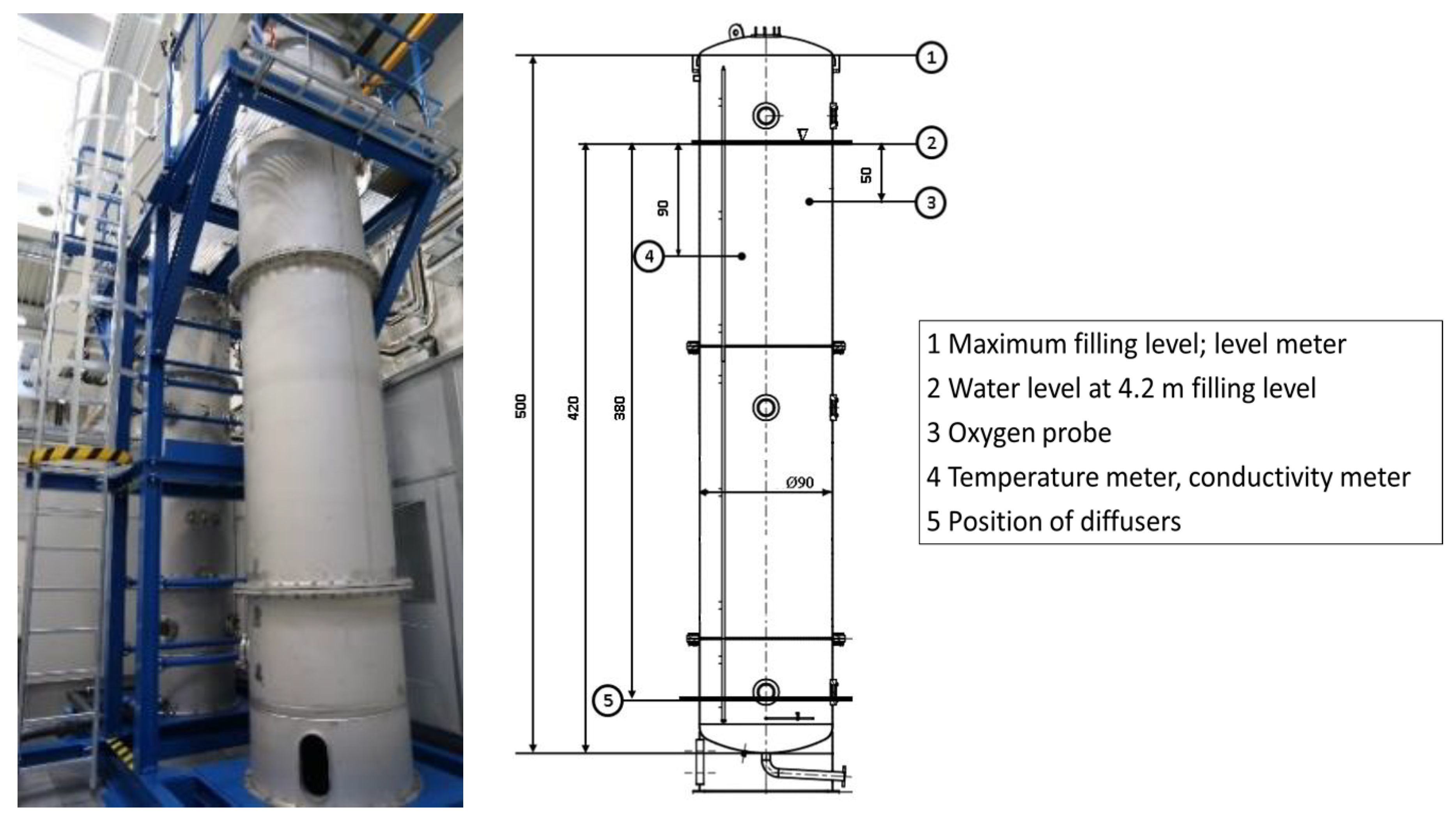

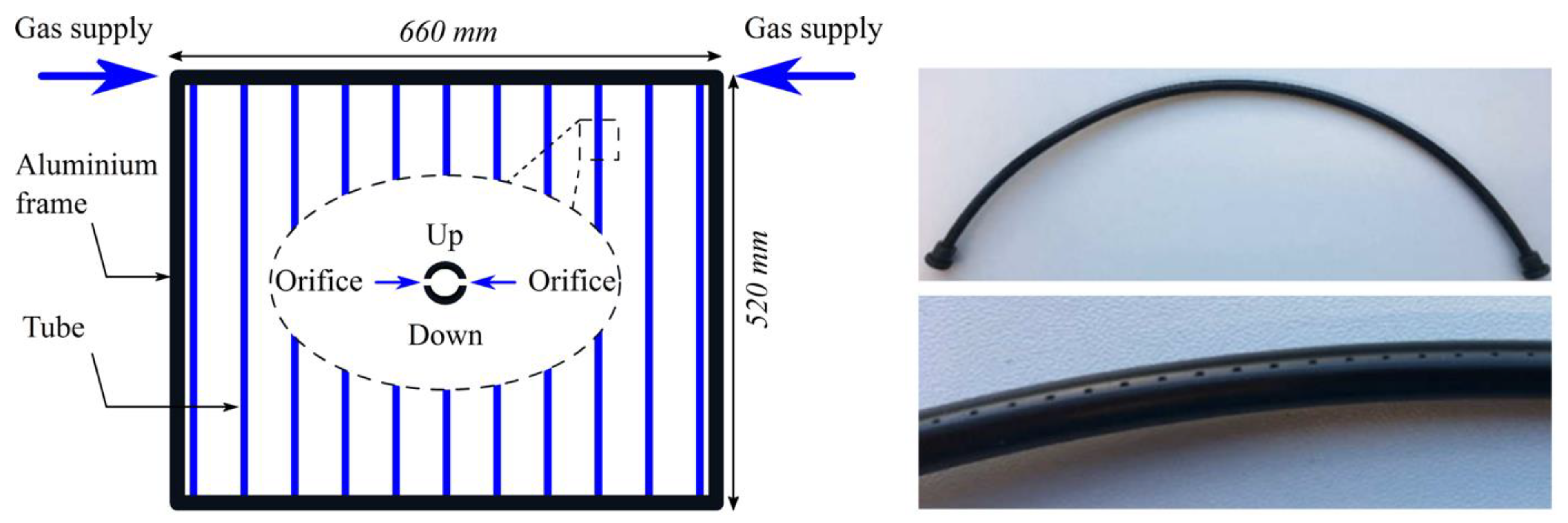
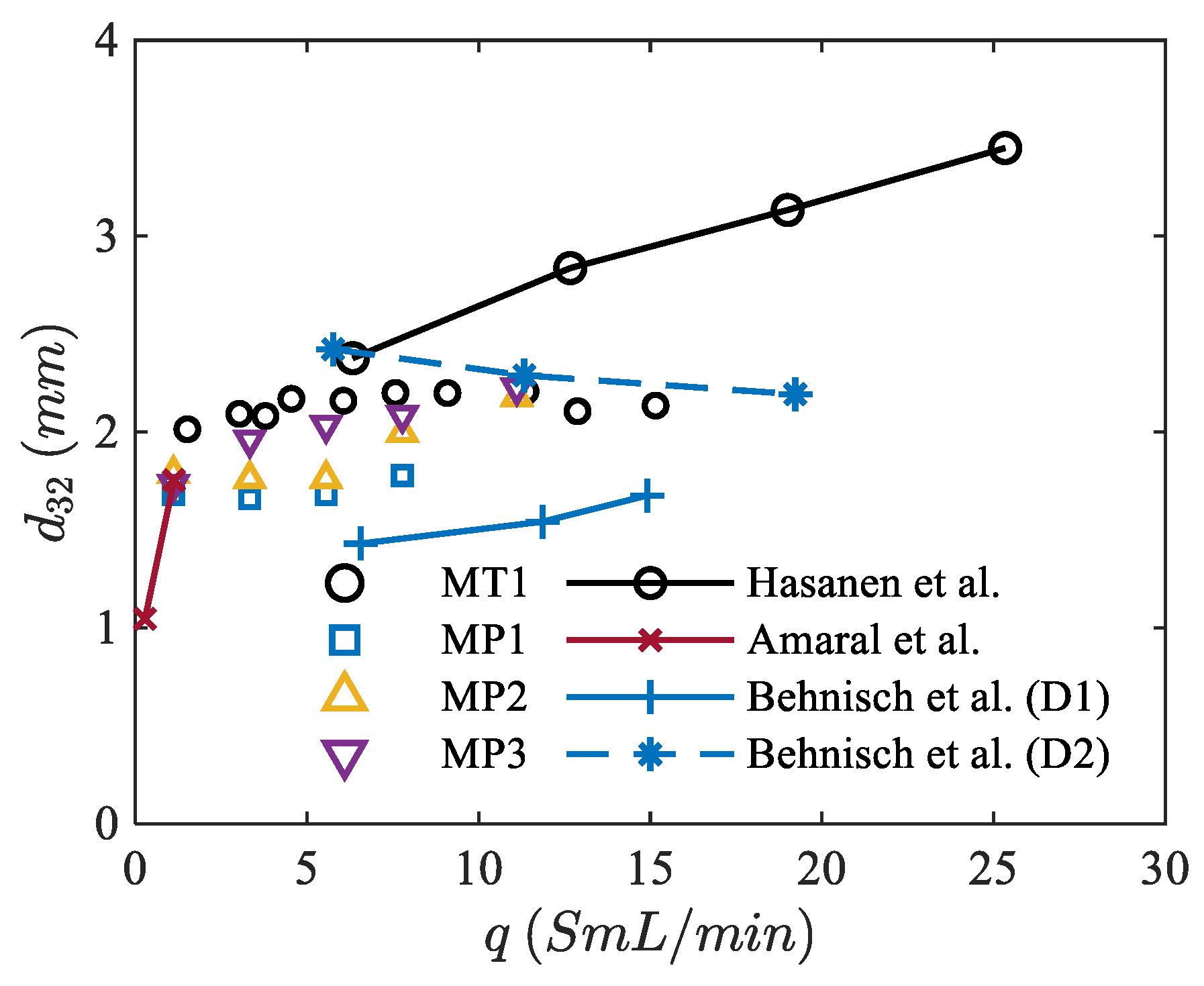

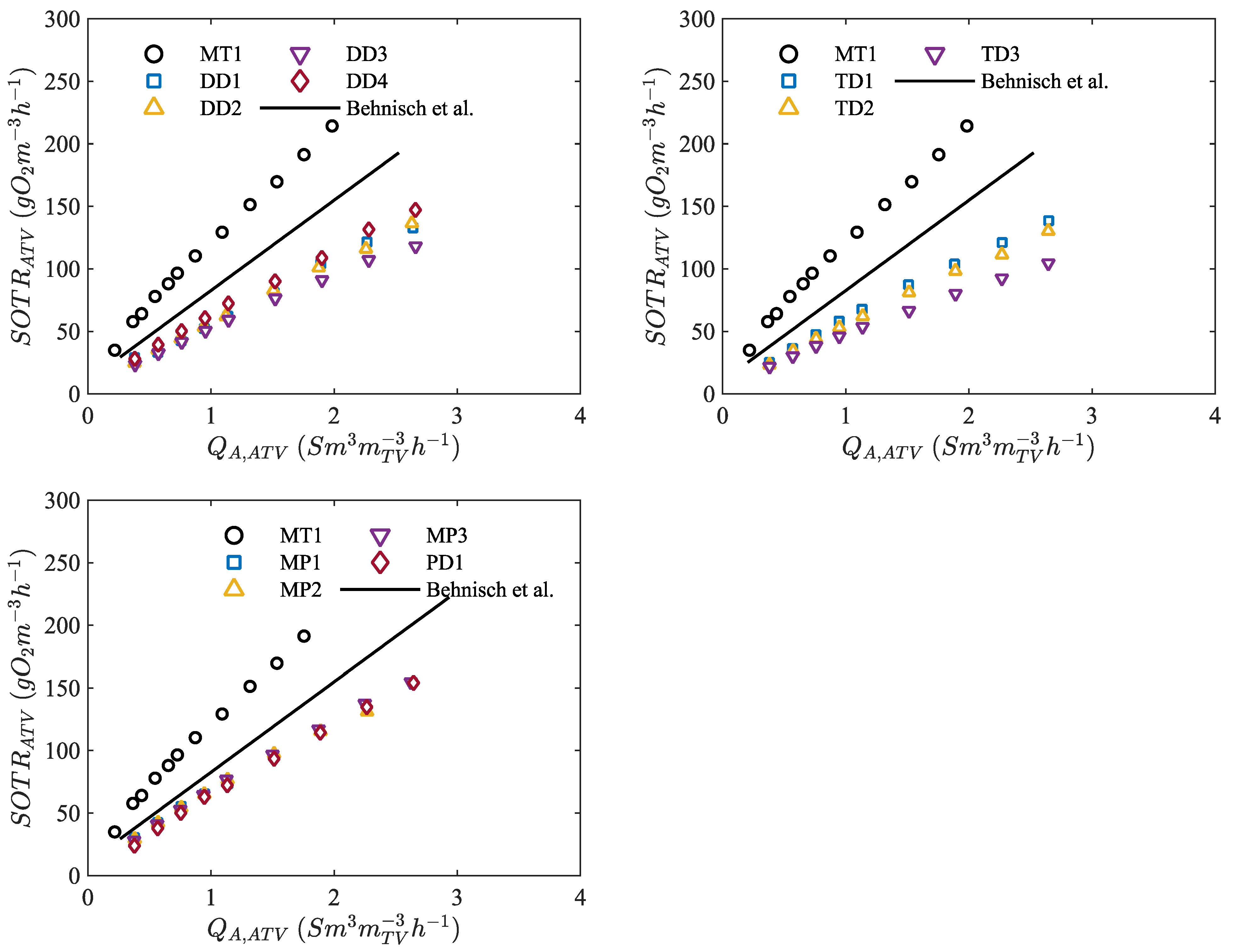
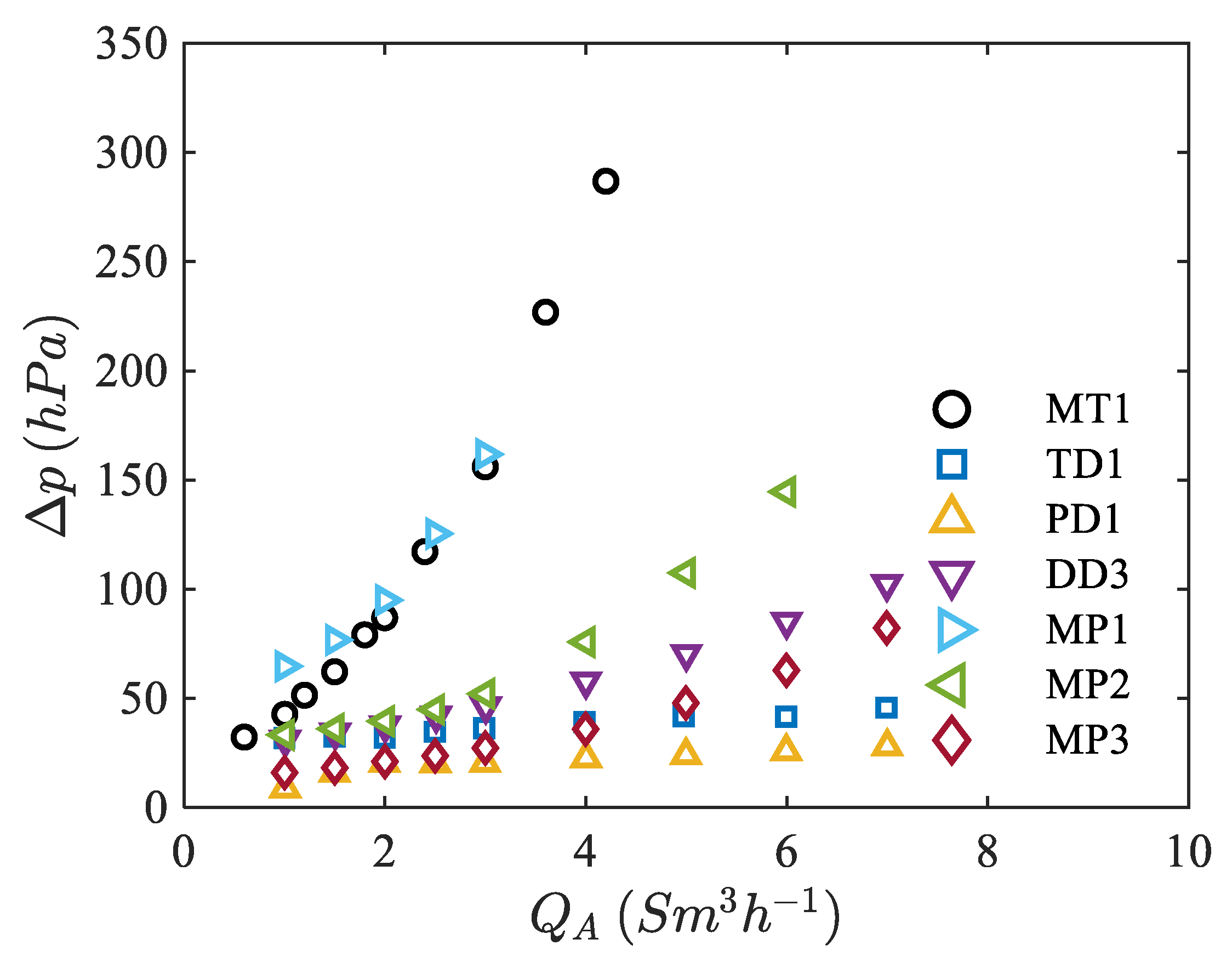
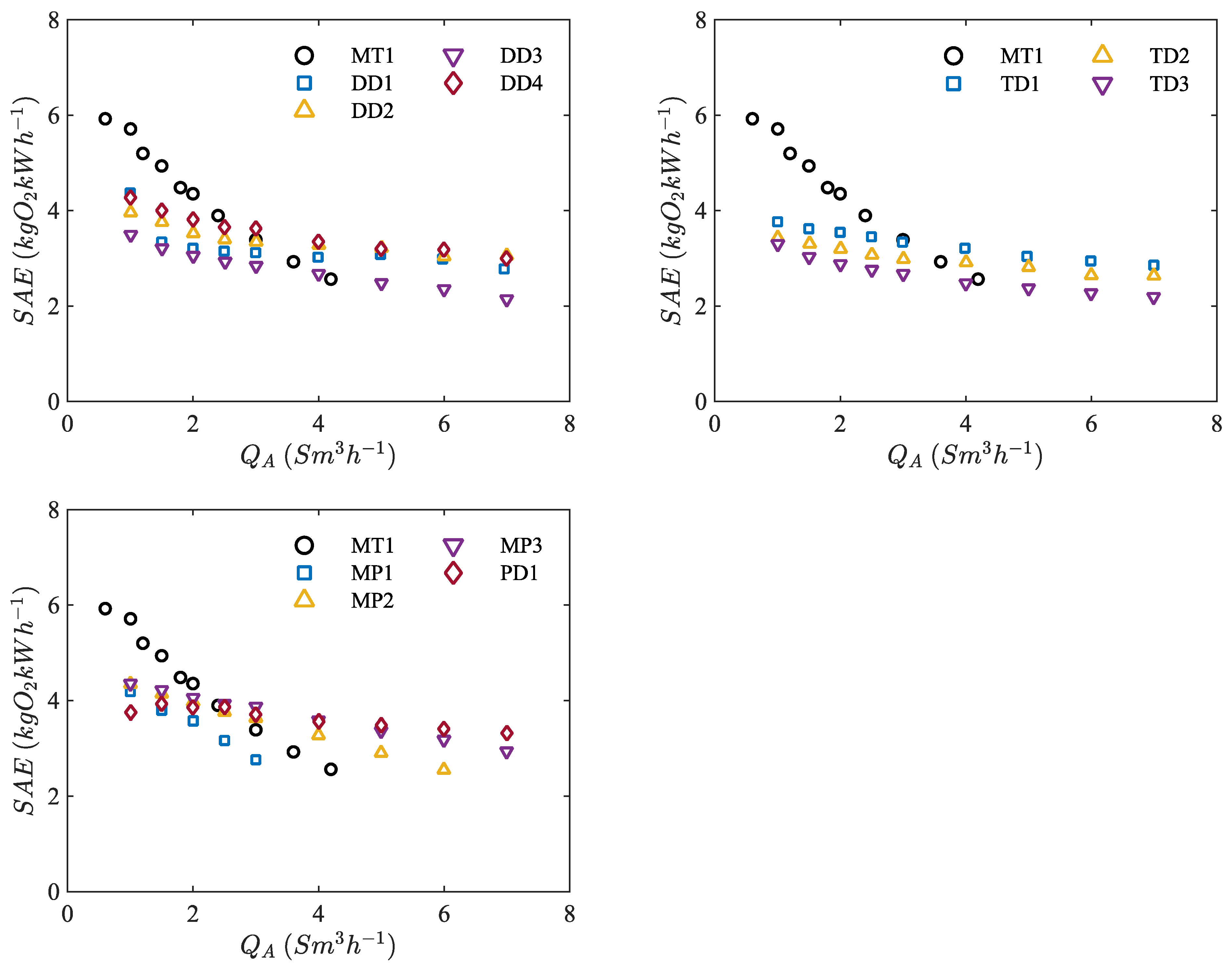
| Name | Membrane Area Material | Membrane Surface Area (m2) | Outer Diameter (mm) | Length of Diffuser (mm) | Diffuser Width (mm) | Orifice Number Per Diffuser | Orifice Diameter/Slit Length (mm) | Effective Orifice Density (cm−2) |
|---|---|---|---|---|---|---|---|---|
| PD1 | TPU | 0.100 | - | 675 | 215 | 9300 | 1 | 9.30 |
| DD1 | EPDM | 0.070 | 350 | - | - | 7100 | 1 | 10.14 |
| DD2 | EPDM | 0.055 | 278 | - | - | 7500 | 1.5 | 13.64 |
| DD3 | EPDM | 0.038 | 265 | - | - | 5800 | 1 | 15.26 |
| DD4 | EPDM | 0.060 | 346 | - | - | 8000 | 1 | 13.33 |
| TD1 | EPDM | 0.075 | 75 | 530 | - | 7500 | 1 | 10.00 |
| TD2 | PU | 0.090 | 65 | 580 | - | 9100 | 1 | 10.11 |
| TD3 | EPDM | 0.090 | 70 | 600 | - | 14,300 | 1.5 | 15.89 |
| MP1 | SS | 0.040 | - | 135 | 135 | 2900 | 0.03 | 7.25 |
| MP2 | SS | 0.040 | - | 135 | 135 | 1500 | 0.05 | 3.75 |
| MP3 | SS | 0.040 | - | 135 | 135 | 1300 | 0.07 | 3.25 |
| MT1 | PA | 0.104 | - | 500 | 6 | 3672 | 0.05 | 3.53 |
Publisher’s Note: MDPI stays neutral with regard to jurisdictional claims in published maps and institutional affiliations. |
© 2021 by the authors. Licensee MDPI, Basel, Switzerland. This article is an open access article distributed under the terms and conditions of the Creative Commons Attribution (CC BY) license (https://creativecommons.org/licenses/by/4.0/).
Share and Cite
Herrmann-Heber, R.; Ristau, F.; Mohseni, E.; Reinecke, S.F.; Hampel, U. Experimental Oxygen Mass Transfer Study of Micro-Perforated Diffusers. Energies 2021, 14, 7268. https://doi.org/10.3390/en14217268
Herrmann-Heber R, Ristau F, Mohseni E, Reinecke SF, Hampel U. Experimental Oxygen Mass Transfer Study of Micro-Perforated Diffusers. Energies. 2021; 14(21):7268. https://doi.org/10.3390/en14217268
Chicago/Turabian StyleHerrmann-Heber, Robert, Florian Ristau, Ehsan Mohseni, Sebastian Felix Reinecke, and Uwe Hampel. 2021. "Experimental Oxygen Mass Transfer Study of Micro-Perforated Diffusers" Energies 14, no. 21: 7268. https://doi.org/10.3390/en14217268
APA StyleHerrmann-Heber, R., Ristau, F., Mohseni, E., Reinecke, S. F., & Hampel, U. (2021). Experimental Oxygen Mass Transfer Study of Micro-Perforated Diffusers. Energies, 14(21), 7268. https://doi.org/10.3390/en14217268







